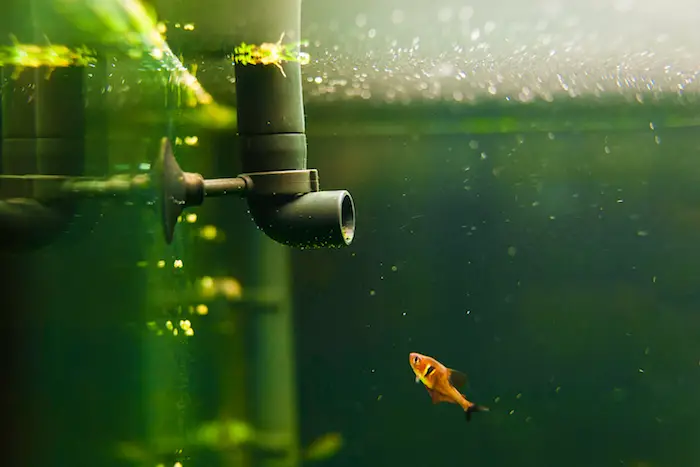Silence the Bubbles: Tips for Quieting Your Fish Tank Filter
To make a fish tank filter quieter, add foam or a pre-filter sponge to the water intake and output. This will reduce the noise level significantly.
A fish tank filter is essential for maintaining a healthy aquarium, but it can also create a lot of noise through the water flow. This noise can be a disturbance, especially if the fish tank is located in a living area such as a bedroom or living room.
Fortunately, there are several ways to make a fish tank filter quieter without compromising its effectiveness. In this article, we’ll discuss some simple ways to reduce the noise level of your fish tank filter by adding foam or a pre-filter sponge to the water intake and output. Additionally, we’ll explore some other tips to help you create a peaceful and enjoyable aquarium environment.

Credit: www.amazon.com
Key Factors That Cause Loud Fish Tank Filters
Discuss Common Causes Of Noisy Fish Tank Filters
A noisy fish tank filter can be frustrating to deal with, especially if you’re looking for a peaceful aquatic setting. There could be several reasons why your fish tank filter is making noise, including:
- Incorrect placement of filter components
- Buildup of debris inside the filter
- Mechanical problems within the filter
- Vibrations caused by the filter
- Air leaks or blockages in the tubes
Explain The Science Behind The Causes Of Loud Fish Tank Filters
Fish tank filters use a motor to pump water through the filter media, which removes impurities and harmful substances from the water. The motor generates vibrations that can cause noise if the filter components are not correctly positioned. Debris buildup can cause blockages in the filter, increasing resistance to water flow and making the motor work harder, leading to more vibrations and noise.
Finally, air leaks or blockages in the tubes can cause water to churn, creating more noise.
Highlight The Problems Associated With Noisy Tanks
A noisy fish tank can cause significant problems for both your fish and you. Here are a few reasons why you should take steps to decrease noise levels in your aquarium:
- Noise can be stressful for fish, causing them to become agitated and increasing their cortisol levels.
- Loud filters can disrupt your peaceful surroundings and lead to difficulty concentrating or relaxing.
- Constant noise can also lead to hearing loss over time, affecting your overall quality of life.
Reducing noise levels in your fish tank filter can improve the quality of life for your aquatic pets and create a serene environment for you to enjoy.
Tips And Tricks For Keeping Your Fish Tank Filter Silent
As an aquarium enthusiast, you know how important it is to keep your fish tank filter quiet. Fish are especially sensitive creatures that require a peaceful environment to thrive. A noisy filter can easily frighten your fish and cause them significant stress.
If you’re tired of the constant noise coming from your aquarium, here are some tips and tricks you can use to help silence your fish tank filter.
Provide Actionable Tips To Help Silence Your Fish Tank Filter
- Place a towel or foam padding underneath the filter to absorb vibrations and prevent them from being transferred to the surface the tank is sitting on.
- Use a rubber o-ring or gasket to seal any loose connections and prevent leaks that could contribute to unwanted noise.
- Check to see if your filter’s impeller, or the rotating component that moves water through the filter, is spinning correctly. A damaged impeller can produce a knocking noise that can be easily fixed by replacing it with a new one.
- Consider purchasing a new filter that’s specifically designed to be silent. Canister filters and hang-on-back filters tend to be quieter than their internal counterparts.
- Place the filter on the opposite end of the tank from your fish to create some distance and reduce the filter’s impact on the tank’s sound level.
Discuss How To Pick The Right Kind Of Filter For Your Aquarium
Picking the right filter for your aquarium is crucial when it comes to minimizing noise levels. Here are some factors to consider when choosing a fish tank filter:
- Tank size: Choose a filter that’s designed to handle the size of your aquarium. An undersized filter will have to work harder, making more noise in the process.
- Filtration type: Different types of filters, including internal, hang-on-back, and canister, utilize different methods to filter the water in your tank. Consider each type’s pros and cons and how each one may affect noise levels.
- Flow rate: Pick a filter with a flow rate that’s appropriate for your tank. Too high of a flow rate can create noise and disturb your fish, while a low flow rate may not be effective at filtering the water.
- Filter media: Consider the type of filter media that the filter uses, such as sponge or bio-media, to determine how effective it will be at filtering the water and how much noise it’s likely to produce.
Highlight The Importance Of Regular Cleaning And Maintenance
Regular cleaning and maintenance are key to keeping your fish tank filter quiet. Here are some essential cleaning and maintenance tasks to stay on top of:
- Replace filter media regularly: As filter media gets clogged with debris, it becomes less effective at filtering the water and will produce more noise as water tries to pass through.
- Clean the impeller: An impeller that’s dirty or clogged with debris can prevent water from being moved through the filter correctly, leading to noise and other issues.
- Check for leaks: Leaks in your filter can cause unwanted noise and may also be indicative of a larger problem that needs to be addressed.
- Regularly inspect the filter, tubing, and connections, and clean out any debris to prevent blockages and unnecessary noise.
Keeping your fish tank filter silent doesn’t have to be a complicated process. By implementing these tips and tricks and staying on top of regular cleaning and maintenance, you can create a peaceful and harmonious environment for your fish to thrive in.
How To Build A Diy Soundproofing Gasket For Your Fish Tank Filter
Are you tired of hearing your fish tank filter constantly buzzing and rattling in the background? Fortunately, there’s a simple solution: a diy soundproofing gasket that you can easily create at home. Not only will this help to reduce the noise level, but it’s also an affordable alternative to purchasing an expensive new filter.
Step By Step Guide For Building A Diy Soundproof Gasket:
- Start by measuring the dimensions of your filter and noting them down.
- Next, purchase a sheet of sound-deadening material, such as neoprene or foam rubber, that is of the appropriate thickness to create a barrier between the filter and tank.
- Using the measurements you took earlier, cut out a piece of sound-deadening material to fit snugly on top of your filter.
- Once you have your cut-out piece, use an adhesive spray to attach it directly to the top of your filter.
- Finally, replace the cover on your filter and voila – you now have a much quieter filter.
List Of Materials Needed For The Project:
- Measuring tape
- Sound-deadening material (neoprene or foam rubber)
- Scissors
- Adhesive spray
Highlight The Benefits And Cost-Effectiveness Of A Diy Soundproofing Solution:
With a diy soundproofing gasket, you not only reduce the noise level of your fish tank filter, but you also avoid the high costs associated with purchasing a brand new filter. It is an affordable and effective solution for anyone who wants a quieter fish tank without the hefty price tag.
Plus, this is a quick and easy project that doesn’t require any special skills or tools, making it an accessible diy option for everyone.
Building a diy soundproofing gasket for your fish tank filter is a sensible solution for anyone who desires a quieter home aquarium. By following these simple steps and investing in a few basic materials, you can create an affordable and effective sound barrier for your filter in no time.
So, try out this project and see the difference it makes to your fish tank’s peace and quiet.
How To Conduct Routine Maintenance For Your Fish Tank Filter
Aquariums are a great way to liven up a space and bring a hint of nature indoors. A key aspect of maintaining a healthy fish tank is by ensuring that its filter is working optimally. Over time, filters can become noisy, or they may malfunction.
Conducting regular maintenance on your fish tank can help keep your aquarium’s filtration system in good health so that your fish can thrive. Below, we discuss the overview of regular filter maintenance, the importance of consistent maintenance, and how to troubleshoot basic filter problems.
Offer An Overview Of Regular Filter Maintenance
The best approach to ensuring that your filter is working correctly is through consistent maintenance. If you set up a weekly or bi-weekly maintenance schedule, you will help sustain your filter’s health. Below are some key steps to include in your maintenance routine:
- Conduct a partial water change – start by replacing between 25% to 50% of the water in your fish tank weekly.
- Clean the filter media – rinse or replace the filter media. This should be done every month or fortnight to keep it in good condition.
- Check the filter motor – ensure that the motor is running smoothly. If there are any suspicious noises, it could be time to clean or replace the impeller.
Emphasize The Importance Of A Consistent Maintenance Regime
Regular filter maintenance is essential for fish tank health. It’s essential to note that filters are the primary source of biological filtration in a fish tank. If your filter is not working correctly, toxins will begin to accumulate in your fish tank, leading to health problems for your fish.
A consistent maintenance regime is an effective way to avoid this and safeguard the health of your fish.
Discuss How To Troubleshoot Basic Filter Problems
Occasionally, issues may arise with your fish tank filter system. The good news is that basic maintenance and troubleshooting skills can help iron out issues with your filter. Below are some basic steps to follow if you experience issues with your filter:
- Shut down the filter system and unplug it from the power source.
- Troubleshoot – check the filter media, the impeller, and other vital components for blockages or defects.
- Clean – rinse or replace the filter media, clean the motor parts that manage the impeller.
- Start it up – once you’re confident all components are functioning correctly, you can switch the filter back on.
Filters are critical elements in keeping fish tanks healthy and functional. Following a regular maintenance routine will keep them in good health, and in the event of any basic issues, you can troubleshoot using the steps above. You and your fish will both benefit from your diligence, resulting in a healthy and happy aquarium.
Frequently Asked Questions Of How To Make A Fish Tank Filter Quieter
How Can I Reduce Fish Tank Filter Noise?
To reduce fish tank filter noise, you can try placing foam to dampen vibrations, cleaning the filter, or moving the tank.
Can I Use A Different Filter To Make It Quieter?
Yes, some filters are designed to be quieter than others. Hang-on-back or canister filters tend to make less noise than internal filters.
Should I Change The Position Of My Filter?
Yes, moving the filter to a different location can help reduce noise. Try placing it on a rubber mat or in a lower water level.
Is There Anything Else I Can Do To Make My Filter Quieter?
You can add baffles to the filter to reduce the water flow noise or switch to a filter with a rubber impeller for quieter operation.
Conclusion
Overall, a noisy fish tank filter can disrupt the peaceful atmosphere of your tank. Fortunately, there are several ways to reduce the noise level of your filter. Identifying the root cause of the noise, selecting the right filter accessories, and proper maintenance can go a long way in achieving a quiet filter.
Silencing your filter not only creates a better living environment for your fish but also allows you to enjoy the peaceful ambiance of your tank. With a little creativity, patience, and determination, you can successfully reduce the noise levels of your fish tank filter.
Implementing these simple steps can ensure that you enjoy your tank and its inhabitants with minimal disturbance. So, start your journey to a quiet filter with the tips mentioned in this guide, and watch your aquarium become a peaceful oasis in your home.






